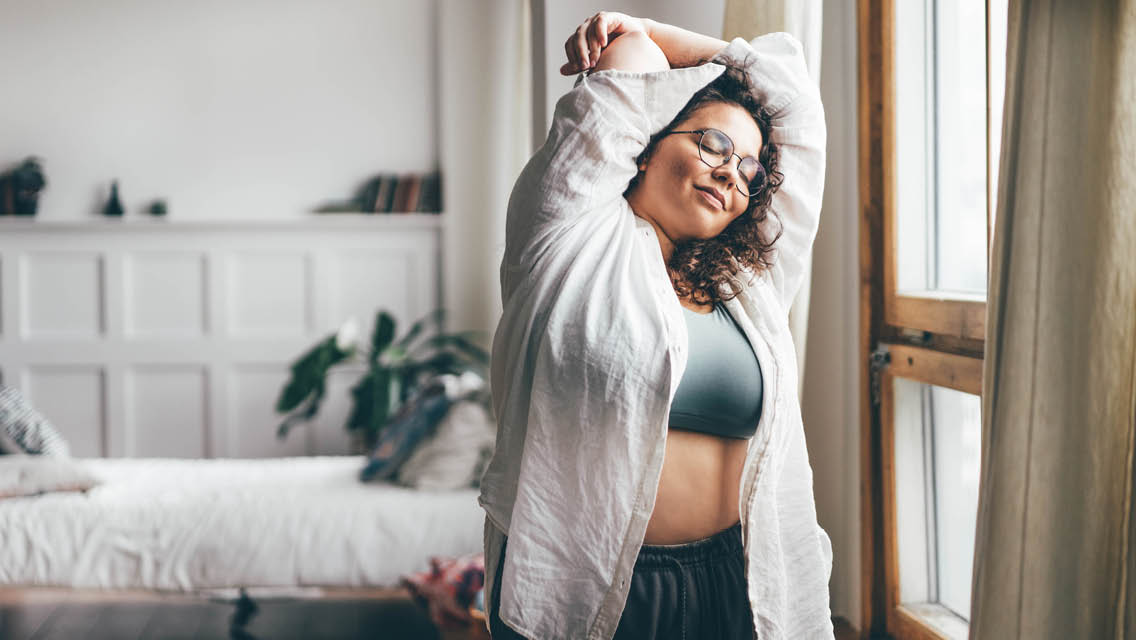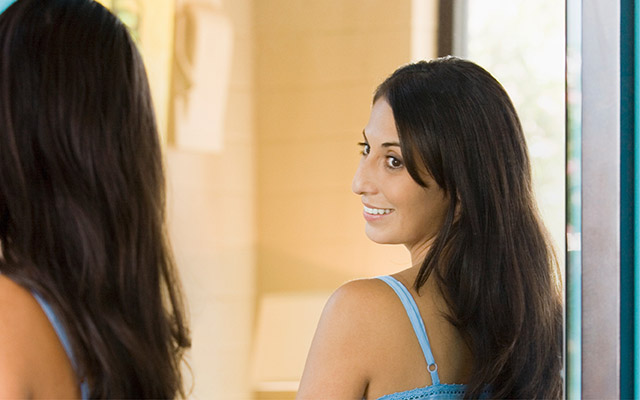Explore this article:
6 Ways to Practice Body Neutrality ⋅ How to Start Using Body-Neutral Language
“You do not have to love your body to be happy with it.”
In the spring of 2021, Natalie Horn was a business major in her junior year at the University of Washington, embarking on a project about body neutrality for a sociology class. That sentence, tucked into the introduction of her resulting term paper, turned out to be more than just a great thesis. It became a personal mantra that transformed how Horn saw herself.
“Body positivity works for many people, but I’ve never been one of them,” Horn says. “It felt forced and caused me to think about my body just as much as when I felt negative about it. Taking this step toward nonjudgment, toward being neutral, has changed my mindset, and that’s changed how I live.”
Like fish that are unaware of the water they swim in, most of us spend our days immersed in a value-laden sea of body judgments — offhand comments about weight loss, social-media images held up for comparison, advertisements that prompt insecurity and then promise to quash it — so commonplace we don’t even notice them anymore. Forget imagining a life without the belief that bodies can be right or wrong, good or bad.
Yet there is a growing movement encouraging us to get our heads above water and recognize this sea of messages.
That’s what body neutrality is all about.
Shifting to Neutral
Although the phrase “body neutrality” emerged around 2015, the concept was soon popularized by body-image coach Anne Poirier, author of The Body Joyful: My Journey From Self-Loathing to Self-Acceptance.
Poirier, a certified intuitive-eating counselor, was working at a retreat center in 2016, preparing to teach a class on body image, when she first encountered the term on an older presentation. The concept so intrigued her that she developed a four-part series on body neutrality and has spearheaded work in the field ever since.
“Everyone at that retreat hated their bodies so much it was ridiculous to suggest they simply love themselves,” she recalls. “We talked about how to live in our bodies, instead of beating ourselves up all the time about what we ‘need’ to change.”
She suggested the attendees think of body neutrality as a resting place between body hate and body love, where they could move away from the chaos of their thoughts and beliefs about their bodies.
That experiment wasn’t only for retreat participants, she says — it was a new way of thinking for her as well.
“Up until that point, I’d only ever thought about what my body couldn’t do. I focused on what was wrong with it, through comparison, criticism, and judgment,” she says.
Stepping into the body-neutrality mindset, Poirier gained a sense of ownership over her body and began to listen to it and trust what it was trying to tell her. “I started by being grateful for what my body could do at any given moment and disconnected from what it looked like.”
“I started by being grateful for what my body could do at any given moment and disconnected from what it looked like.”
That midway point between hate and love doesn’t mean indifference, she emphasizes. You’re not ignoring the fact that your body exists or avoiding mirrors. Instead, body neutrality involves cultivating an awareness of your perceptions about your body — and the bodies of others — and changing your inner talk in a meaningful way.
Interior chatter isn’t only about how you look, Poirier adds. It usually has something to say about all aspects of your body and how you direct it, from exercise to intimacy to chronic-illness management.
Body neutrality aims to step away from expectations about how you should be and get closer to how you are, without labels like good, bad, worthy, unworthy, able-bodied, desirable, etc.
It’s not easy. In fact, Poirier concedes that the breadth of conditioning we’ve all undergone since childhood makes refashioning our thoughts incredibly tough.
“The biggest part of body neutrality is changing the conversation with yourself,” she says. “Can you think of your body differently and be grateful for everything it lets you do? That’s what changes the relationship with your body, and honestly, it takes a great deal of effort. Body work like this is uncomfortable because we have connected it to our self-worth.”
Still, the relief that comes with a more neutral perspective — especially if we’ve been stuck in the body-hate end of the pool — can be profound.
A New View of Positivity
For many people, body neutrality involves questioning both their disparaging thoughts and their encouraging ones.
Messages such as “Love your body” and “Every body is beautiful” have helped plenty of people, especially those whose bodies have been traditionally excluded from the narrow category of acceptability, feel more at ease. Yet body positivity’s relentless focus on the body can backfire.
“For some, body positivity can feel like another type of pressure, as if you’re failing when you don’t ‘love the skin you’re in,’ for example,” says Chrissy King, author of The Body Liberation Project: How Understanding Racism and Diet Culture Helps Cultivate Joy and Build Collective Freedom.
Affirming a body that has made you the target of other people’s negative assumptions can be difficult, even if it’s those assumptions — not your body — that are the problem.
“Often, people feel like they can love their bodies as long as they change a few aspects of themselves, but that doesn’t bring freedom. It also doesn’t acknowledge that some people live in bodies that are marginalized, like being Black, fat, or transgender,” King adds. Affirming a body that has made you the target of other people’s negative assumptions can be difficult, even if it’s those assumptions — not your body — that are the problem.
King believes that body neutrality gets closer to acknowledging, on a collective level, the systems of oppression that are informed by racism, diet culture, and anti-fat bias. When we start to take a neutral attitude toward our own bodies as well as the bodies of other people, it reveals how arbitrary so-called good and bad body traits really are.
At this point, the benefits extend beyond the individual, King explains. The more each of us begins to understand and practice body neutrality, the more it drives a cultural shift toward the acceptance of all bodies.
“That’s how we get to body liberation,” she says. “It starts on an individual level, and then you begin to see the impact of that on everyone around you.”
No Comparison
It’s perfectly reasonable to embrace body positivity and body neutrality; you don’t need to choose just one. Some days a positivity approach might help boost your mood, while on other days that same messaging might feel hollow. A body-neutral attitude can support you during periods of physical discomfort or intense self-consciousness, and then you might come through that rough patch and feel like celebrating.
That leads to another major principle of body neutrality: You’re always changing, and that’s OK.
Poirier says a body-neutrality mindset understands and appreciates that your body is changing from day to day — sometimes within the same day. The you of today is not the same as the you of yesterday or tomorrow.
“Part of neutrality is embracing that we are continually changing and choosing to flow with it instead of fighting against it.”
That sense of impermanence may feel destabilizing at first. Ultimately, though, it can free us. “Part of neutrality is embracing that we are continually changing and choosing to flow with it instead of fighting against it,” explains Poirier. Instead of the mental tug of war that can come with tightly holding a positive view of your body as you try to escape a negative one, neutrality encourages you to just let go.
Consider aging. Your body as a teen is different from your body as a young parent, for instance, and that’s different from how your body looks and feels as you head past 60.
With a neutral mindset, these changes are not a problem; they just are. You can release the belief that how you look is either good or bad, or a mix of both.
“This disentangles our identity and self-worth from our bodies,” says Anjali Ferguson, PhD, a Virginia-based clinical psychologist who focuses on social equity, racial trauma, and early childhood mental health. “That’s challenging to do because from a very early age, we’ve tied these together. But it’s never too late to have the awareness around how it’s affecting you.”
6 Ways to Practice Body Neutrality
Body neutrality may feel like an abstract concept, says Poirier. Though its nebulous qualities can seem like a drawback at first, especially if you like rules and programs, the upside is that body neutrality offers a framework that’s easily modified based on your needs. Give it a try with these mindset-shifting habits and behaviors.
1) Practice body scans.
Mindfulness meditation can help you truly feel your body, says Ferguson. Some guided meditations involve a “body scan,” in which you focus on feeling your toes, then your feet, then your ankles, and so on. If you’ve been disconnected from your body for some time, just sensing your breath in your chest and feeling how your chest rises and falls can be a profound experience.
“When you get into your body this way,” she explains, “it’s easier to let your thoughts come and go, which is another way meditation can help.” Extend this to practice nonattachment to your thoughts about your body, letting them flow without judgment or fixation.
2) Get specific with gratitude.
Poirier expresses gratitude to her body daily as part of her neutrality practice. She thanks her eyes for allowing her to see the sunset, her arms for letting her hug her daughter, her legs for taking her on a long walk.
“It sounds silly to say things like that out loud,” she admits. “Like, ‘Thank you, fingers, for helping me type.’ But your brain doesn’t think it’s silly. It’s using that appreciation to rewire your perspective.”
That gratitude applies to her changes as well, she adds. For example, instead of feeling discouraged when her pants feel tighter than they were a few weeks before, she appreciates the solidity of her thighs and the feeling of strength that brings.
3) Move in new ways.
When Horn, the University of Washington business major, began her introspection about body neutrality, she noticed that going to the gym often felt like a chore, so she replaced some of her gym time with roller skating and hiking because she loves how those activities make her body feel.
Even for those who feel like the gym is their happy place, finding new ways to move can reveal unknown capacities, suggests functional-medicine coach Mark Schneider, CPT, whose Retreat Strength Gym offers trauma-informed strength training.
“Maybe you explore being able to do things you didn’t think were possible before, and study the effects of that,” he says. “That could allow you to relate differently to yourself.”
4) Take your time.
Poirier suggests approaching body neutrality as you would any new relationship, allowing for a getting-to-know-you period. It takes time, curiosity, openness, vulnerability, and appreciation to create layers of trust and understanding.
The same is true when you’re cultivating a fresh way to relate to your body — particularly if you’ve spent years or even decades considering it an enemy to be thwarted.
Those negative attitudes don’t disappear overnight, adds body-image coach and podcast host Jessi Kneeland. “You’re dealing with layers of meaning you’ve put on your body, and you’re likely dealing with subconscious emotional needs that may be driving your behavior,” she says.
“In some cases, you may be starting with learning how to feel worthy of pleasure. Don’t add stress by trying to shorten the timeline for all this. Body image can be a huge block. It takes time to chip away at it.”
5) Listen to yourself.
Body neutrality involves developing a greater awareness of what you’re thinking, feeling, and communicating, says Ferguson. Noticing how you feel in your body is crucial, but it’s also important to listen to what you’re saying about the bodies of other people — even celebrities.
That’s challenging. Casual conversations frequently include references to appearance. But starting to notice your inner monologue as well as conversations with others can be helpful (see “Body-Neutral Language,” below). Once you begin recognizing how language affects how you feel in your body, you can take a significant step toward neutrality.
6) Expect a ripple effect.
Adopting just one or two of these behaviors for a couple of weeks can help you navigate toward a more neutral mindset. And don’t be surprised if this creates changes you didn’t anticipate.
When Horn began to include more neutral self-talk in her mindfulness practice, for example, she also decided to stop straightening her hair — she realized she was responding to other people’s expectations. That saved her an hour every morning, so she began sleeping in, and found she woke up feeling much more energized. (For more guidance on softening self-criticism and changing your internal dialogue for the better see, “6 Strategies to Improve Your Self-Talk” .)
She also began wearing looser and softer clothes, which made her feel like she could move with greater ease.
Horn’s body-neutrality project offered one more unexpected benefit: She decided to switch her professional focus from business to sociology, allowing her to bring these insights to a wider audience.
“My comfort and enjoyment now come before anything else, and I want other people to feel like this,” she says. “I don’t practice body neutrality 100 percent of the time — I’m not sure anybody could. But in making these small changes and embracing how I feel, not how I look, I’m letting my body be itself a little more, and that’s powerful.”
How to Start Using Body-Neutral Language
Casual remarks like “Have you lost weight?” “You look great!” or “That cake is going straight to my hips!” are usually meant to be kind or funny. Yet no matter how well-meaning they are, such statements help reinforce a status quo that suggests thinness is better, says Chrissy King, author of The Body Liberation Project. They contribute to the idea that there’s a “right” way to look — and that any body that isn’t slender and fit (and probably white, gender-conforming, and able-bodied) doesn’t qualify.
When you’re cultivating a more body-neutral mindset, King recommends paying close attention to your words. “Start listening to how you approach body topics in your conversations,” she says. “If everything you’re saying is around appearance, and you’re assigning value to yourself or others based on that, what does that say about your perspective?”
Every body deserves respect and compassion, King adds, and she acknowledges that expressing those values is not easy for many people — especially when they’re talking about themselves.
In that case, the first step may be hearing how you talk to yourself, says body-image coach Anne Poirier, author of The Body Joyful. “We’re so programmed to talk down to ourselves,” she says. “There’s almost a sense of belonging and community when you’re out with friends and everyone is beating themselves up. When that happens, pause. Sometimes, that’s all it takes to reset your self-talk and the conversation. Just stop, listen, remember the size of your body is not related to your worth.”
(For more on dealing with diet talk, see “How to Halt Diet Talk.”)
This article originally appeared as “Embracing Body Neutrality” in the June 2023 issue of Experience Life.





This Post Has 2 Comments
Really enjoyed this article. I like the idea of going forward with our goals for our body without beating ourselves up! I like the idea of being grateful for what our bodies can do rather than what they can’t.
I love and appreciate the practice of moving away from what bodies look like, and I am working on refraining from making comments about how other people’s bodies appear. My struggle comes when someone makes a comment about my body because I don’t want to reinforce the usual stereotypes and acknowledge/accept what they believe to be a compliment about the current state of my body. How can one gracefully deflect unwanted comments from others?